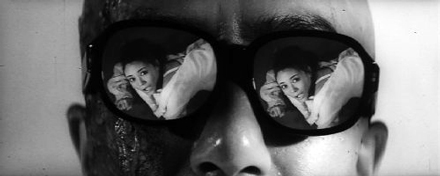The Living Skeleton (reviewed by Lisa Marie Bowman)
This 1968 Japanese horror film opens with a scene of shocking brutality.
A group of pirates, led by a horribly scarred man wearing reflective glasses, have commandeered a ship. While the crew and the passengers beg for mercy, the pirates ruthlessly and efficiently gun them down. A newlywed (Kikko Matsuoka) is assaulted while her husband watches. Afterwards, both of them are murdered. The dead are dumped overboard and the pirates proceed to move on with their lives.
Three years later, neither the ship nor the dead have ever been recovered. The sister of the murdered newlywed, Saeko (also played by Matsuoka), has been taken in by a friendly priest (Masumi Okada). As we discover, the pirates have all returned to their day-to-day lives in the seaside village, with the only indication of their past evil being the violent flashbacks that appear whenever one of them shows up on screen. Almost all of the pirates appear to have returned to the village, everyone but their scarred leader. What has happened to him and how could a man with such an unforgettable face have simply vanished? The pirates aren’t sure but then again, does it matter? They’ve gotten away with their crime. Everyone thinks that the ship was lost at sea.
However, one day, Saeko and her boyfriend go scuba diving. As they explore the undersea world, they come across hundreds of skeleton, all chained together. That night, a ghostly ship appears out on the ocean and Saeko hears a voice calling for her. The priest counsels Saeko not to obsess over the skeletons and not to fall prey to the temptation of vengeance, but that’s far easier said than done.
Meanwhile, the pirates start to die, one-by-one….
The Living Skeleton is an austere and haunting ghost story. Though the story may be a bit conventional, the film is so full of grim atmosphere and portents of ominous doom that it doesn’t matter. Playing out at its own deliberate pace, this film is an effective horror story that asks whether the sins of the past can ever be forgiven. (It turns out, not surprisingly, that they can not.) The black-and-white cinematography adds to the film’s dream-like feel. Long after the film ends, you’ll remember the images. You’ll remember the suffering reflected in the lenses of the head pirate’s glasses. You’ll remember the atmospheric shots of the lonely ocean. You’ll remember the film’s ending, with the remaining pirates watching as their former victim descends down a flight of stair. Unfortunately, you’ll probably also remember just how fake the underwater skeletons looked but even that, in its strange way, adds to the film’s effectiveness. They’re such a strange sight, those pristine, clean, and neat skeletons that you can’t help but feel that they belong in the film, just as surely as the unforgettable shot of a pirate’s face being quickly dissolved by highly corrosive acid belongs in the film.
I saw this haunting ghost story on TCM. Keep an eye out for future showings.


